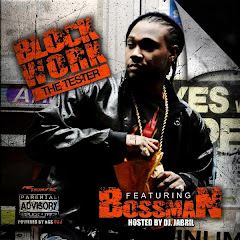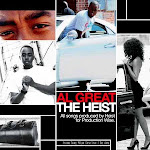
Is Jay Tryin to Justify His Affiliation with Freemasonry???? IDK!!! Listen 4 Ur Self....It Sounds Good, But I Aint Buyin It....Beside That, The Track Is FIRE!!!
DISCLAIMER 'AN I HEARD 'EM SAY DOES NOT CLAIM COPYRIGHT TO ANY IMAGES OR VIDEOS ON THIS SITE. THE PICTURES/VIDEOS ARE SOLEY FOR ENTERTAINMENT PURPOSES.
Duce Wayne and Al Great "Give N Go" from Lionel Cook for RAG Productions on Vimeo.
Al Great "All On Me" video from Lionel Cook for RAG Productions on Vimeo.

Eminem "3AM" music video from Syndrome on Vimeo.
 Producer Jermaine "JD" Dupri recently talked about not having an executive producer role on Usher's new Raymond v. Raymond album.
Producer Jermaine "JD" Dupri recently talked about not having an executive producer role on Usher's new Raymond v. Raymond album.


 Faisal Shahzad, here in an undated photo from the social networking site Orkut.com, was arrested late Monday in connection with Saturday's failed bombing in Times Square in New York. Shahzad, 30, is a naturalized U.S. citizen from Pakistan. He was due in court Today.
Faisal Shahzad, here in an undated photo from the social networking site Orkut.com, was arrested late Monday in connection with Saturday's failed bombing in Times Square in New York. Shahzad, 30, is a naturalized U.S. citizen from Pakistan. He was due in court Today.

 Dorothy I. Height, 98, a founding matriarch of the American civil rights movement whose crusade for racial justice and gender equality spanned more than six decades, died early Tuesday morning of natural causes, a spokesperson for the National Council of Negro Women said.
Dorothy I. Height, 98, a founding matriarch of the American civil rights movement whose crusade for racial justice and gender equality spanned more than six decades, died early Tuesday morning of natural causes, a spokesperson for the National Council of Negro Women said.She died at 3:41 a.m. at Howard University Hospital, a spokesman there said.
Ms. Height was president of the National Council of Negro Women for 40 years, relinquishing the title in 1997. The 4 million-member advocacy group consists of 34 national and 250 community-based organizations. It was founded in 1935 by educator Mary McLeod Bethune, who was one of Ms. Height's mentors.
As a civil rights activist, Ms. Height participated in protests in Harlem during the 1930s. In the 1940s, she lobbied first lady Eleanor Roosevelt on behalf of civil rights causes. And in the 1950s, she prodded President Dwight D. Eisenhower to move more aggressively on school desegregation issues. In 1994, Bill Clinton awarded her the Presidential Medal of Freedom, the nation's highest civilian honor.
In a statement issued by the White House, President Obama called Height "the godmother of the Civil Rights Movement and a hero to so many Americans."
"Dr. Height devoted her life to those struggling for equality . . . witnessing every march and milestone along the way," Obama said. "And even in the final weeks of her life -- a time when anyone else would have enjoyed their well-earned rest -- Dr. Height continued her fight to make our nation a more open and inclusive place for people of every race, gender, background and faith."
In the turmoil of the civil rights struggles in the 1960s, Ms. Height helped orchestrate strategy with movement leaders including the Rev. Martin Luther King Jr., Roy Wilkins, A. Philip Randolph, Whitney Young, James Farmer, Bayard Rustin and John Lewis, who later served as a Democratic member of the U.S. House of Representatives from Georgia.
Ms. Height was arguably the most influential woman at the top levels of civil rights leadership, but she never drew the major media attention that conferred celebrity and instant recognition on some of the other civil rights leaders of her time.
In August 1963, Ms. Height was on the platform with King when he delivered his "I have a dream" speech at the Lincoln Memorial. But she would say later that she was disappointed that no one advocating women's rights spoke that day at the March on Washington for Jobs and Freedom. Less than a month later, at King's request, she went to Birmingham, Ala., to minister to the families of four black girls who had died in a church bombing linked to the racial strife that had engulfed the city.
"At every major effort for social progressive change, Dorothy Height has been there," Lewis said in 1997 when Ms. Height announced her retirement as president of the National Council of Negro Women.
Early champion for women's rights
As a champion of social justice, Ms. Height was best known during the early years of her career for her struggles to overcome racial prejudice.
She was also energetic in her efforts to overcome gender bias, and much of that work predated the women's rights movement. When President John F. Kennedy signed the Equal Pay Act in 1963, Ms. Height was among those invited to the White House to witness the ceremony. She returned to the White House in 1998 for a ceremony marking the 35th anniversary of that legislation to hear Clinton urge passage of additional laws aimed at equalizing pay for men and women.
"Dorothy Height deserves credit for helping black women understand that you had to be feminist at the same time you were African . . . that you had to play more than one role in the empowerment of black people," Del. Eleanor Holmes Norton (D-D.C.) once said.
As president of the National Council of Negro Women, Ms. Height was instrumental in organizing and sponsoring programs that emphasized self-help and self-reliance.
Those included nutrition, child care, housing and career counseling. In response to a public TV program, "The Vanishing Black Family," Ms. Height helped create and organize the Black Family Reunion Celebration, which has been held on the Mall and in cities across the country annually since 1985. The gatherings are intended to honor the traditions, strength and history of African American families while seeking solutions to such social problems as teen pregnancy and drug abuse.
"The reunion is as important today as some of our marches were in the past," Ms. Height said in 1992.
In 1995, Ms. Height was among the few women to speak at the Million Man March on the Mall, which was led by Louis Farrakhan, the chief minister of the Nation of Islam. "I am here because you are here," she declared. Two years later, at 85, she sat at the podium all day, in the whipping wind and chill rain, at the Million Woman March in Philadelphia.
"She was a dynamic woman with a resilient spirit, who was a role model for women and men of all faiths, races and perspectives. For her, it wasn't about the many years of her life, but what she did with them," said former U.S. Secretary of Labor Alexis M. Herman, a close friend who has been running day-to-day operations at the National Council.
Herman called Ms. Height "a national treasure who lived life abundantly. She will be greatly missed, not only by those of us who knew her well, but by the countless beneficiaries of her enduring legacy."
A constant fight for equality
Dorothy Irene Height was born in Richmond on March 24, 1912, and she grew up in Rankin, Pa., near Pittsburgh, where she attended racially integrated schools. But she felt the lash of racial bigotry early in her life. A music teacher in her mostly white elementary school appointed her student director of the school chorus, but a new principal forbade her to take that position. At the next school assembly, the chorus refused to stand and sing until Ms. Height was reinstated as leader, and the principal relented.
The principal subsequently became one of her staunchest supporters, Ms. Height recalled in her 2003 memoir, "Open Wide the Freedom Gates."
As a high school senior and the valedictorian, she won a national oratorical contest, and with it a $1,000 college scholarship. But the college of her choice, Barnard in New York, had already admitted its quota of black students -- two. When Ms. Height applied, she was informed that she would have to wait at least a semester before she could enroll.
Instead, she went to New York University, where she graduated in three years and received a master's degree in educational psychology in her fourth year. In 1980, Ms. Height was chosen to receive Barnard's Medal of Distinction -- the highest honor the college can give.
As a young woman, Ms. Height made money through jobs such as ironing entertainer Eddie Cantor's shirts and proofreading Marcus Garvey's newspaper, the Negro World. She went nightclubbing in Harlem with composer W.C. Handy.
Ms. Height began her professional career as a caseworker for the New York City welfare department. She got her start as a civil rights activist through the Rev. Adam Clayton Powell Sr., pastor of the Abyssinian Baptist Church in Harlem, and from the pastor's son, the Rev. Adam Clayton Powell Jr., who later represented Harlem in the U.S. House of Representatives.
Ms. Height later said that as an officer of the Harlem Christian Youth Council, "I was one of the multitude whose first experience as a civil rights activist was in walking and talking with merchants on 125th Street."
'Freedom in a colorless society'
After attending an international church youth conference in London in the summer of 1937, Ms. Height returned to New York with the conviction that she needed to operate from a broader base than that of a welfare caseworker. She found her opportunity that November at the Harlem branch of the YWCA during a visit by Eleanor Roosevelt. Bethune, president of the Harlem YWCA, was impressed by Ms. Height's poise and style in greeting the president's wife, and she promptly offered her a job. "You come back -- we need you," Ms. Height recalled Bethune saying.
Quitting her job as a welfare caseworker, Ms. Height joined the staff of the Harlem YWCA. She remained a full-time YWCA staffer until 1975, serving the last 18 years simultaneously as president of the National Council of Negro Women.
As a child, she had once been turned away from the Pittsburgh YWCA swimming pool. As a YWCA staff member, she was instrumental in bringing about an interracial charter for Ys in 1946.
In the 1940s, Ms. Height came to Washington as chief of the Phyllis Wheatley YWCA branch. She joined the staff of the national YWCA board in 1944, and, until 1975, she remained on that staff with a variety of responsibilities, including leadership training and interracial and ecumenical education. In 1965, she organized and became the director of the YWCA's Center for Racial Justice, and she held that position until retiring from the YWCA board in 1975. She was a visiting professor at the Delhi School of Social Work in India, and she directed studies around the world on issues involving human rights.
Ms. Height became national president of the Delta Sigma Theta sorority in 1947, and she held that position until 1957, when she became the fourth president of the National Council of Negro Women.
Over the next four decades, she established a national reputation as a graceful and insistent voice for civil rights and women's rights. She was tall and stately -- some said regal -- and she spoke in a tone that always commanded attention. She rarely had to raise her voice.
"If the times aren't ripe, you have to ripen the times," she liked to say. It was important, she said, to dress well. "I came up at a time when young women wore hats, and they wore gloves. Too many people in my generation fought for the right for us to be dressed up and not put down."
Ms. Height never married. She is survived by one sister, Anthanette Height Aldridge of New York City. She was often described as the "glue" that held the family of black civil rights leaders together. She did much of her work out of the public spotlight, in quiet meetings and conversations, and she was widely connected at the top levels of power and influence in government and business.
In the 1960s, Ms. Height was uncomfortable with the "black power" rallying cry of young civil rights militants, and she said that the phrase "has harmed our cause. . . . The fact of the matter is that we do not want black power for American negroes. We don't want white power for American whites. . . . The kind of power we seek is the power of freedom in a colorless society -- the power to help build a constructive nation and a constructive world together with our fellow Americans."
But in time, Ms. Height would revise her opinion and say the "black power" slogan had merit. "White power in the system in which we live is a reality. . . . Simply talking about bettering race relations without changing the power relations will get us nowhere."
Influence from Mississippi to Africa
As the women's rights movement gained momentum in the early 1970s, Ms. Height forged alliances with white feminist leaders, while disagreeing periodically on matters of tactics and racial emphasis. "African American women have advanced in every field that women have advanced, but the sad point is that those are the few and not the many," she said.
Under her leadership, the National Council of Negro Women sponsored voter registration drives and organized an education foundation for student activists who interrupted their education to do civil rights work.
Another 1960s program, Wednesdays in Mississippi, was a favorite of Ms. Height's. It consisted of weekly trips to Mississippi by interracial groups of women to assist at Freedom Schools and voter registration campaigns. This was often perilous work, especially during the summers of 1964 and 1965, when the hundreds of young civil rights volunteers who streamed into Mississippi were routinely harassed, sometimes beaten and, in a few cases, killed.
In the 1970s and 1980s, the council helped organize and operate development projects in African countries. It ran a "pig bank" project in rural Mississippi in which pigs were given to poor, hungry families so they could raise them, with the understanding that two pigs from subsequent litters would be put back into the bank for another family.
Over the years, there were fundraising drives for a statue of Bethune and acquisition of a large and imposing headquarters building in downtown Washington to house the National Council and the Dorothy I. Height Leadership Institute. The building, with white oak woodwork, a marble staircase and fluted cast-iron columns, stands at 633 Pennsylvania Ave. NW, the site of what was once a slave market. For years after stepping down as president of the National Council, Ms. Height made daily visits to her office there, using a walker or a wheelchair as she became infirm.
"She not only expected us to keep going, she instructed us to keep going," Herman said. "She would ball that fist up and say that the National Council of Negro Women wasn't about one or two persons. She balled her fist to say that you can strike a mighty blow when you make a fist and work together."
Ms. Height had served on the advisory council of the White House Initiative on Historically Black Colleges and Universities and the National Advisory Council on Aging. Her awards included 36 honorary doctorates from colleges and universities, including Harvard and Princeton. On March 24, 2004, her 92nd birthday, she received the Congressional Gold Medal, the highest decoration Congress can bestow.
But Ms. Height often urged her co-workers to "stop worrying about whose name gets in the paper and start doing something about rats, and day care and low wages. . . . We must try to take our task more seriously and ourselves more lightly."

 Kids these days really don’t know how good they have it. Back in my day, having one’s video game
Kids these days really don’t know how good they have it. Back in my day, having one’s video game What do you think of the Boy Scouts officially sanctioning our (lucky) youths’ love of video games? Let’s see a show of hands from the jealous over-20s crowd in the house who’d love to turn back time right about now.
[via Engadget]








 One is a hip-hop legend, the other descends from reggae royalty. This May, Nas and Damian 'Jr. Gong' Marley are teaming up for what could be the most groundbreaking new 2010 album to hit stores all year. 'Distant Relatives,' the long awaited collaboration album from the duo has been talked about for quite some time, now -- some would say, far too long.
One is a hip-hop legend, the other descends from reggae royalty. This May, Nas and Damian 'Jr. Gong' Marley are teaming up for what could be the most groundbreaking new 2010 album to hit stores all year. 'Distant Relatives,' the long awaited collaboration album from the duo has been talked about for quite some time, now -- some would say, far too long.




M.I.A, Born Free from ROMAIN-GAVRAS on Vimeo.










